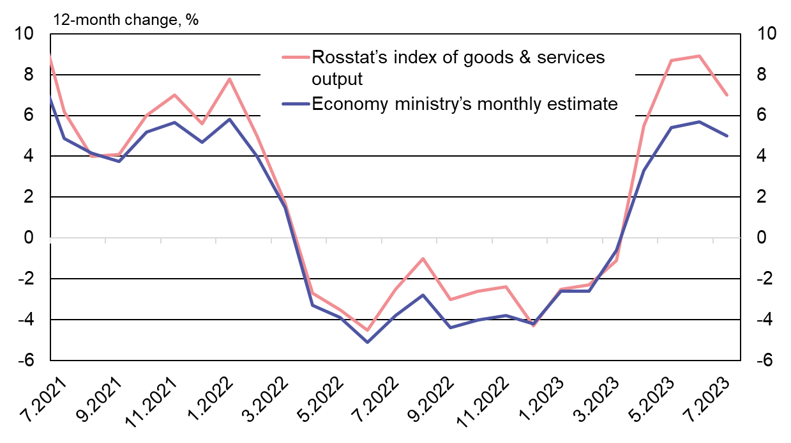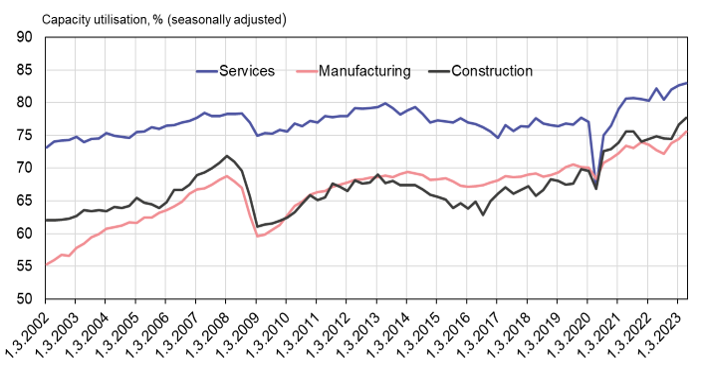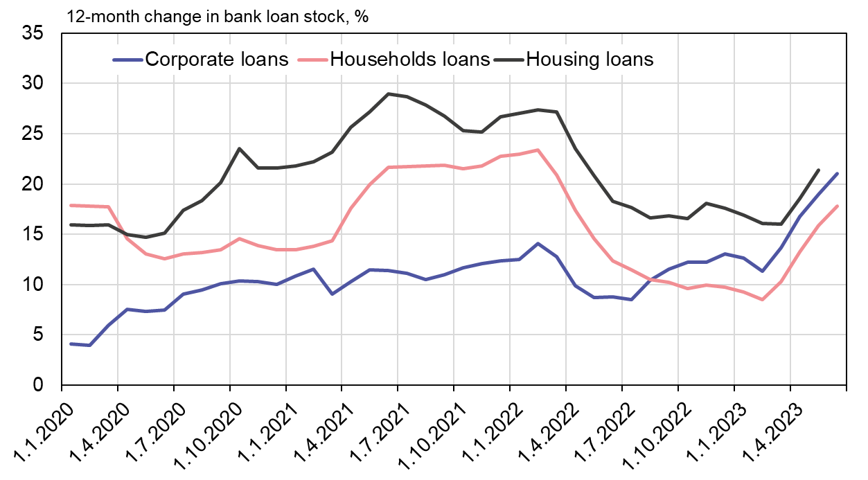BOFIT Weekly Review 35/2023
Russian growth supported by increased bank lending and heavy public spending
Russian economy again showed positive growth in July
Even with the pace of growth moderating in recent months, the latest Rosstat figures show that on-year growth remained strong in July. Growth was especially robust in service branches such as restaurant services (up 11 %) and retail sales (up 10.5 %). Some of the growth figures in these branches reflects the low reference basis of a year earlier. Growth in real wages and consumer credit helped fuel domestic demand for services. Private consumption was also supported by increased public spending on wages, social support and compensation to mobilised reservists.
The pace of economic growth has stabilised in recent months.
 Sources: Rosstat, Russian Ministry of Economic Development, CEIC, BOFIT.
Sources: Rosstat, Russian Ministry of Economic Development, CEIC, BOFIT.
Consolidated budget spending rose in nominal terms by 18 % y-o-y in the first six months of this year. Growth in federal budget spending focused on supplying the needs of the war effort, which was reflected in the high growth posted in some manufacturing branches. In July, industrial output overall grew by 4.9 % y-o-y. Vigorous growth continued to be registered in manufacturing branches associated with defence: “other metal products” (10 %), transport vehicles other than automobiles (67 %), computers and electronics including navigational devices (43 %), electrical equipment (30 %) and special-purpose clothing (40 %).
Some of the growth in defence spending was reflected in increased fixed investment. Rosstat reports that fixed investment growth accelerated in April-June, and for all of the first half was up by 7 % y-o-y. At the same time, the average share of direct budget outlays for financing of all fixed investment rose slightly to 17 %. Investment growth was highest in branches supporting the defence industry: “other metal products” (42 %), transport vehicles other than automobiles (29 %), computers and electronics including navigational devices (54 %), electrical equipment (36 %) and public administration (75 %), as well as pipeline transmission of natural gas (77 %).
Construction activity was up 7 % in July, even if growth slowed slightly. The contraction in housing construction that began late last year continued, however. The volume of completed apartments fell by 2 % y-o-y in July. Despite growth in the stock of housing loans, demand for new housing appears to have subsided.
The strong resurgence in domestic demand has left many branches swamped with orders. Utilisation of industrial capacity has reached all-time highs and unemployment has fallen to record lows. Many firms report that the lack of qualified workers is their biggest obstacle to growth. The production bottlenecks increase price pressures. As a result, both inflation and inflation expectations have increased again. Russia’s on-year inflation was 4.3 % in July and is expected to have reached 5 % in August.
Preliminary Rosstat figures show GDP contracted by 1.8 % y-o-y in the first quarter of this year and grew by 4.9 % in the second quarter. In January-June, growth reached 1.6 % y-o-y.
Capacity utilisation has reached all-time highs in production of both goods and services.
 Source: Central Bank of Russia.
Source: Central Bank of Russia.
Sharp increase in bank lending in the first half of 2023
The credit stock of firms was up 9 % at the end of July, and the household credit stock was up 11 % from the start of this year. The stock of corporate loans in July was up by 21 % y-o-y and household loans by 18 %. The growth in lending has been supported by government interest subsidy programmes and an improved outlook for the Russian economy.
Household borrowing, in particular, was substantially impacted by housing loan programmes introduced during the Covid-19 pandemic. At the start of 2022, the share of housing loans eligible for interest subsidies represented just 5 % of bank lending to households. Today, they account for over a quarter of all household loans. About half of the stock of housing loans now benefits from various forms of government interest subsidies. Demand for consumer loans and car loans dried up almost completely last year, but in the first half of this year demand has revived. As of end-July, the stock of consumer credit had grown by 13 % y-o-y and car loans by 19 %.
New corporate lending was up by about 25 % y-o-y in the first half of this year. The biggest borrowing increases were seen in the transport vehicle and chemical industries, retail and wholesale, as well as the real estate branch. With rapidly rising demand in these branches, capacity utilisation rates have been stretched to all-time highs. The growth in lending is also reflected in the revival of capital investment in these branches.
The currency allocation in bank lending has changed considerably since the outbreak of the Ukraine war. New foreign-currency loans are extremely rare and older loans have been redenominated either in rubles or Chinese yuan. At the beginning of 2022, about a quarter of corporate loans were in foreign currencies. As of July this year, forex loans accounted for just 17 % of the total loan stock. The yuan’s share of forex loans has risen from zero to around 20 %.
The tightening of CBR’s monetary stance and hike in its key rate to 12 % (BOFIT Weekly 33/2023) are expected to slow the pace of lending growth in the months ahead. Interest rates on new corporate loans and consumer credit generally react rapidly to changes in the key rate. Changes in housing loan servicing costs, in contrast, tend to be quite modest. The finance ministry reports that the subsidized interest rate on loans to first-time apartment buyers will remain at 8 % despite the key rate hike. Loans to households are typically fixed rate, so fluctuations in interest rates have little impact on household loan payments.
Bank lending in Russia has increased rapidly this year.
 Source: Central Bank of Russia.
Source: Central Bank of Russia.